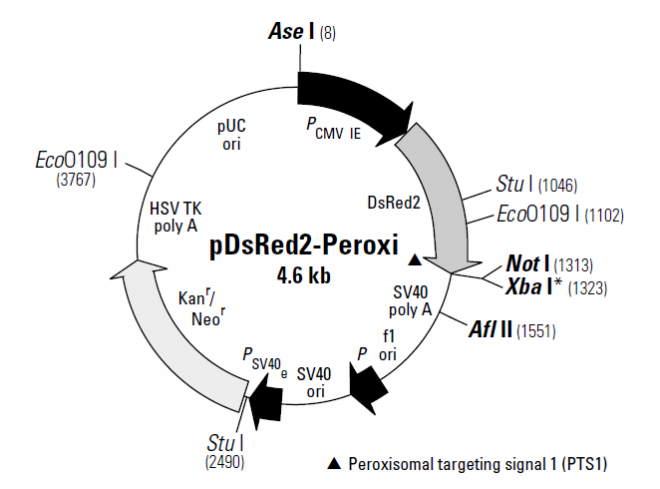pDsRed2-Peroxi 载体
| 质粒类型: | 荧光蛋白报告载体 |
|---|---|
| 启动子: | CMV |
| 克隆方法: | 多克隆位点,限制性内切酶 |
| 载体大小: | 4.6kb (查看载体序列) |
| 载体抗性: | Kanamycin (卡那霉素) |
| 筛选标记: | 新霉素(Neomycin) |
pDsRed2-Peroxi is a mammalian expression vector that encodes a fusion of Discosoma sp. red fluorescent protein (DsRed2; 1, 2) and the peroxisomal targeting signal 1 (PTS1). The PTS1 sequence is fused to the 3'-end of DsRed2, a DsRed variant engineered for faster maturation and lower non-specific aggregation. The PTS1 sequence encodes the tripeptide SKL, which targets the DsRed2-PTS1 fusion protein to the matrix of peroxisomes (3–6).
To drive expression of DsRed2-PTS1, this vector contains the immediate early promoter of cytomegalovirus (PCMV IE). SV40 polyadenylation signals downstream of the DsRed2 gene direct proper processing of the 3'-end of the DsRed2-PTS1 mRNA transcript. Because it encodes DsRed2, a gene variant that uses human-preferred codons (7), the DsRed2-PTS1 transcript is suited for efficient translation in mammalian cells. To further increase the translational efficiency of DsRed2- PTS1, upstream sequences have been converted to a Kozak consensus translation initiation site (8). The vector also contains an SV40 origin for replication in any mammalian cell line that expresses the SV40 T-antigen, a pUC origin of replication for propagation in E. coli, and an f1 origin for singlestranded DNA production. A neomycin resistance cassette—consisting of the SV40 early promoter (PSV40e), the neomycin/kanamycin resistance gene of Tn5 (Neor/Kanr), and polyadenylation signals from the herpes simplex virus thymidine kinase (HSV TK poly A) gene—allow stably transfected eukaryotic cells to be selected using G418 (9). A bacterial promoter (P) upstream of this cassette drives expression of the gene encoding kanamycin resistance in E. coli.
载体应用
pDsRed2-Peroxi is designed for fluorescent labeling of peroxisomes. The vector can be introduced into mammalian cells using any standard transfection method. If required, stable transformants can be selected using G418 (9). The DsRed2-PTS1 fusion (excitation/emission maxima: 558 nm/ 583 nm) can be detected by fluorescence microscopy and by flow cytometry. Filter sets optimized for detecting DsRed by microscopy are available from Chroma Technology Corporation and Omega Optical Inc. Please see their websites (www.chroma.com and www.omegafilters.com) and the Living Colors® Vol. II User Manual, provided with this vector, for more information. To detect DsRed2- PTS1-expressing cells by flow cytometry, use the instrument’s argon-ion laser to excite the fluorophore at 488 nm and the FL-2 channel to detect the fluorophore’s emission at 583 nm.


